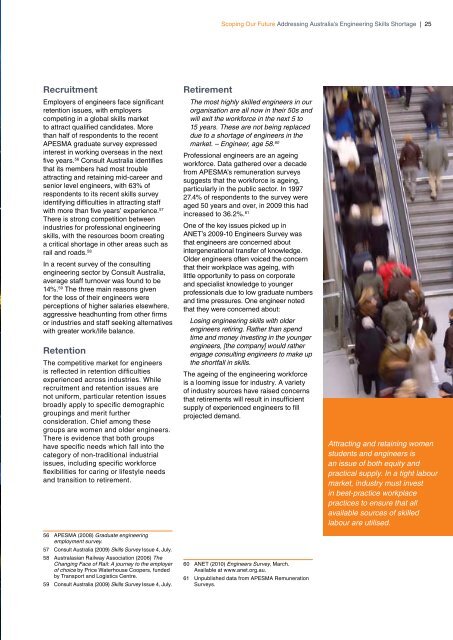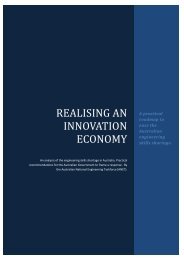scoping our future - ANET - Australian National Engineering Taskforce
scoping our future - ANET - Australian National Engineering Taskforce
scoping our future - ANET - Australian National Engineering Taskforce
You also want an ePaper? Increase the reach of your titles
YUMPU automatically turns print PDFs into web optimized ePapers that Google loves.
Scoping Our Future Addressing Australia’s <strong>Engineering</strong> Skills Shortage | 25RecruitmentEmployers of engineers face significantretention issues, with employerscompeting in a global skills marketto attract qualified candidates. Morethan half of respondents to the recentAPESMA graduate survey expressedinterest in working overseas in the nextfive years. 56 Consult Australia identifiesthat its members had most troubleattracting and retaining mid-career andsenior level engineers, with 63% ofrespondents to its recent skills surveyidentifying difficulties in attracting staffwith more than five years’ experience. 57There is strong competition betweenindustries for professional engineeringskills, with the res<strong>our</strong>ces boom creatinga critical shortage in other areas such asrail and roads. 58In a recent survey of the consultingengineering sector by Consult Australia,average staff turnover was found to be14%. 59 The three main reasons givenfor the loss of their engineers wereperceptions of higher salaries elsewhere,aggressive headhunting from other firmsor industries and staff seeking alternativeswith greater work/life balance.RetentionThe competitive market for engineersis reflected in retention difficultiesexperienced across industries. Whilerecruitment and retention issues arenot uniform, particular retention issuesbroadly apply to specific demographicgroupings and merit furtherconsideration. Chief among thesegroups are women and older engineers.There is evidence that both groupshave specific needs which fall into thecategory of non-traditional industrialissues, including specific workforceflexibilities for caring or lifestyle needsand transition to retirement.56 APESMA (2008) Graduate engineeringemployment survey.57 Consult Australia (2009) Skills Survey Issue 4, July.58 Australasian Railway Association (2006) TheChanging Face of Rail: A j<strong>our</strong>ney to the employerof choice by Price Waterhouse Coopers, fundedby Transport and Logistics Centre.59 Consult Australia (2009) Skills Survey Issue 4, July.RetirementThe most highly skilled engineers in <strong>our</strong>organisation are all now in their 50s andwill exit the workforce in the next 5 to15 years. These are not being replaceddue to a shortage of engineers in themarket. – Engineer, age 58. 60Professional engineers are an ageingworkforce. Data gathered over a decadefrom APESMA’s remuneration surveyssuggests that the workforce is ageing,particularly in the public sector. In 199727.4% of respondents to the survey wereaged 50 years and over, in 2009 this hadincreased to 36.2%. 61One of the key issues picked up in<strong>ANET</strong>’s 2009-10 Engineers Survey wasthat engineers are concerned aboutintergenerational transfer of knowledge.Older engineers often voiced the concernthat their workplace was ageing, withlittle opportunity to pass on corporateand specialist knowledge to youngerprofessionals due to low graduate numbersand time pressures. One engineer notedthat they were concerned about:Losing engineering skills with olderengineers retiring. Rather than spendtime and money investing in the youngerengineers, [the company] would ratherengage consulting engineers to make upthe shortfall in skills.The ageing of the engineering workforceis a looming issue for industry. A varietyof industry s<strong>our</strong>ces have raised concernsthat retirements will result in insufficientsupply of experienced engineers to fillprojected demand.60 <strong>ANET</strong> (2010) Engineers Survey, March.Available at www.anet.org.au.61 Unpublished data from APESMA RemunerationSurveys.Attracting and retaining womenstudents and engineers isan issue of both equity andpractical supply. In a tight lab<strong>our</strong>market, industry must investin best-practice workplacepractices to ensure that allavailable s<strong>our</strong>ces of skilledlab<strong>our</strong> are utilised.




